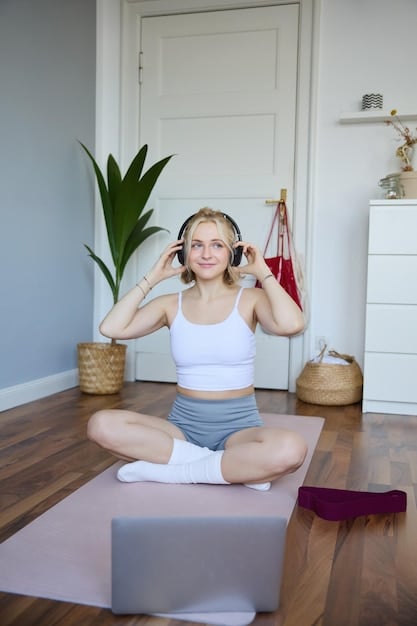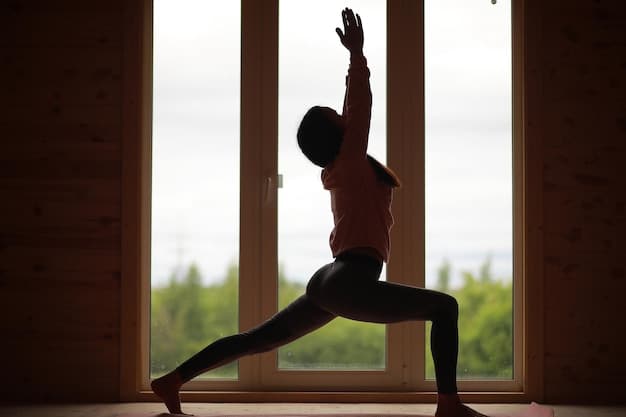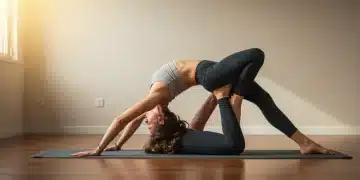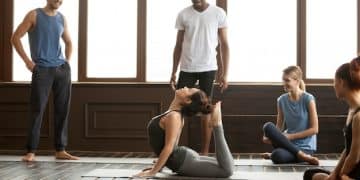Yoga for Beginners: Your 4-Week Guide to Foundational Poses

Yoga for Beginners: A Practical Guide to Mastering the Foundational Poses in 4 Weeks offers a structured introduction to yoga, guiding newcomers through essential poses, breathing techniques, and mindfulness practices to build strength, flexibility, and inner peace.
Embarking on a yoga journey can seem daunting, but with the right guidance, it can become a transformative experience. Yoga for Beginners: A Practical Guide to Mastering the Foundational Poses in 4 Weeks is designed to demystify yoga and provide a clear path for newcomers to build a solid foundation.
Understanding the Basics of Yoga
Before diving into the poses, it’s crucial to understand the fundamental principles of yoga. This involves more than just physical postures; it encompasses breathwork, mindfulness, and a holistic approach to well-being.
The Eight Limbs of Yoga
Yoga is more than just asanas (poses). The eight limbs provide a comprehensive guide to living a fulfilling and ethical life. Understanding these limbs helps beginners appreciate the depth of yoga practice.
Breathing Techniques (Pranayama)
Breath control, or pranayama, is a vital component of yoga. Focusing on your breath helps calm the mind, increase energy levels, and deepen your practice. Practicing simple breathing exercises before starting your poses can greatly enhance your experience.
- Deep Belly Breathing: Inhale deeply, filling your abdomen with air.
- Alternate Nostril Breathing: Balance your energy by alternating between nostrils.
- Ujjayi Breath: Engage your throat slightly for a calming, oceanic sound.

Understanding these basics will help you approach your 4-week journey with a deeper sense of purpose and awareness, setting you up for success in mastering the foundational poses.
Week 1: Building Your Foundation
The first week is all about familiarizing yourself with the most basic poses and proper alignment. Consistency is key, so aim for at least 3-4 sessions this week to build a strong foundation.
Mountain Pose (Tadasana)
This is the foundation for all standing poses. It teaches you to ground through your feet, engage your core, and lengthen your spine. Pay attention to your posture and alignment.
Downward-Facing Dog (Adho Mukha Svanasana)
A staple in yoga, this pose stretches your entire body, strengthens your arms and legs, and calms the mind. Focus on creating a straight line from your hands to your hips.
- Engage your core to prevent sagging.
- Press firmly through your hands and feet.
- Relax your neck and let your head hang loosely.
By the end of week one, you should feel more grounded and connected to your body. Don’t worry about perfection; focus on progress and building a solid foundation for the weeks to come.
Week 2: Strengthening and Stretching
Now that you have a grasp on the foundational poses, week two focuses on building strength and increasing flexibility with slightly more challenging postures.
Warrior I (Virabhadrasana I)
This pose strengthens your legs, opens your hips, and improves your balance. Ensure your front knee is directly over your ankle and your back foot is planted firmly on the ground.
Warrior II (Virabhadrasana II)
A powerful standing pose that strengthens your legs, opens your hips, and improves concentration. Focus on maintaining a stable base and extending your arms strongly in opposite directions.

Remember to listen to your body and modify poses as needed. The goal is to build strength and flexibility gradually, without pushing yourself too hard.
Week 3: Introduction to Balance
Week three introduces balancing poses, which help improve focus, coordination, and mental clarity. These poses require concentration and body awareness.
Tree Pose (Vrksasana)
This grounding pose helps improve balance and focus. Place the sole of your foot on your inner thigh (avoiding the knee) and bring your hands to prayer at your heart center or extend them overhead.
Triangle Pose (Trikonasana)
This pose stretches your hamstrings, opens your hips, and strengthens your legs. Extend your arms in opposite directions and reach towards your foot or shin.
- Keep your chest open and your gaze towards the ceiling.
- Engage your core to maintain stability.
- Use a block if you can’t reach the floor comfortably.
Balancing poses require patience and practice. Don’t get discouraged if you wobble or fall; simply reset and try again. The key is to maintain focus and stay present in the moment.
Week 4: Deepening Your Practice
In the final week, it’s time to consolidate what you’ve learned and deepen your practice. This involves linking poses together in a short flow and exploring modifications to suit your individual needs.
Sun Salutations (Surya Namaskar)
A sequence of poses that warms the body, increases circulation, and prepares you for a deeper practice. Flow through the poses with your breath, moving smoothly from one to the next.
Seated Forward Fold (Paschimottanasana)
This pose stretches your hamstrings, spine, and shoulders. Sit with your legs extended and reach towards your toes, keeping your spine as straight as possible.
As you deepen your practice, remember to stay connected to your breath and maintain a sense of mindfulness. Yoga is not just about physical postures; it’s about cultivating a deeper connection to yourself.
Tips for Continued Progress
Once you’ve completed the 4-week program, it’s important to maintain your practice and continue to progress. Here are some tips to help you stay motivated and deepen your yoga journey.
Join a Yoga Class
Taking a yoga class can provide guidance, motivation, and a sense of community. A qualified teacher can offer personalized instruction and help you refine your poses.
Practice Regularly
Consistency is key to seeing results. Aim for at least 2-3 sessions per week to maintain your strength, flexibility, and mental clarity.
- Set realistic goals and track your progress.
- Find a time that works for you and stick to it.
- Reward yourself for reaching milestones.
By following these tips, you can continue to deepen your yoga practice and experience the many benefits it has to offer. Remember, yoga is a journey, not a destination, so enjoy the process and celebrate your progress along the way.
| Key Point | Brief Description |
|---|---|
| 🧘 Foundational Poses | Master basic poses like Mountain Pose and Downward-Facing Dog. |
| 🌬️ Breathing Techniques | Practice Pranayama to calm the mind and increase energy. |
| 💪 Strength and Flexibility | Build strength with poses like Warrior I and II. |
| 🧘♀️ Balancing Poses | Improve focus and coordination with Tree Pose and Triangle Pose. |
Frequently Asked Questions
▼
As a beginner, aim for 3-4 sessions per week. Consistency is key to building strength and flexibility. Listen to your body and rest when needed.
▼
Wear comfortable, breathable clothing that allows you to move freely. Avoid anything too tight or restrictive. Bare feet or yoga socks are ideal.
▼
A yoga mat is essential for providing cushioning and grip. Blocks and straps can be helpful for modifications, but aren’t mandatory to start.
▼
Yes, it’s normal to feel some soreness, especially as a beginner. Gentle stretching and hydration can help alleviate discomfort. If pain is severe, consult a doctor.
▼
Start with 30-45 minute sessions and gradually increase the duration as you become more comfortable. Focus on quality over quantity and listen to your body.
Conclusion
Embarking on a 4-week journey to master foundational yoga poses is a fantastic way to introduce yourself to the world of yoga. By focusing on proper alignment, breathwork, and mindfulness, you can build a strong foundation for a lifelong practice that will enhance your physical, mental, and emotional well-being.





